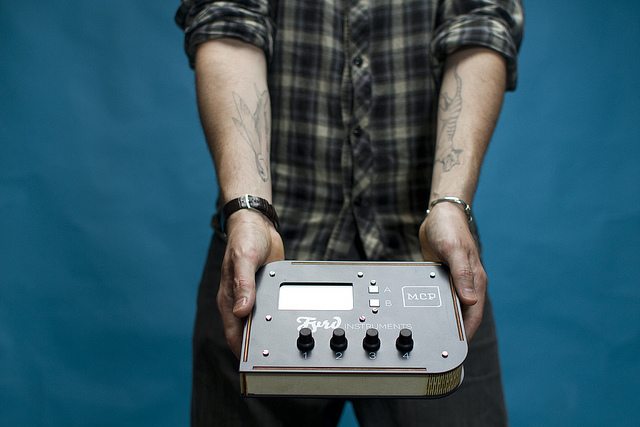What if you just had a box that crunched MIDI data?
In the realm of DIY hardware, ideas tossed aside by the bigger music tech market thrive. And so, we have the MIDI Control Platform, a poplar wood and lasercut-aluminum box with basic controls and a graphic display. It’s a box that does … well, stuff. Via software modules and that screen, it can turn into any MIDI-processing tool you desire. This idea has been seen in boutique hardware before – I loved the Ruin & Wesen MiniCommand, but sadly that device and its MidiDuino library never caught on. The MIDI Control Panel – or MCP, earning snickers from Tron fans – is a new creation that carries on that notion. At 210 € (slightly more when shipped outside of its native France), it’s reasonably affordable, too. And with two software modules, it already covers a range of features. (See also: MidiPal, now shipping, from the creator of the Shruthi-1. That is half the price, and does have MIDI DIN, though it lacks some of the additional controls here and the nice, graphic screen.)
Good news for computer users: USB bus power and MIDI over USB mean you can plug directly into a computer. Bad news for hardware lovers, though: there’s no MIDI DIN, which to me would have been a huge draw for this gadget. (Happily, Fyrd tells us that’s on its way, which for me could make this the perfect standalone box.)
The hardware itself looks lovely: 128×64-pixel LCD, four encoders with integrated switches, and simplified operation. It’s like a little, extra computer for MIDI.
The first of two modules available so far is a “Harmonic Music Generator.” It’s a unique sequencer that automatically harmonizes patterns.
- 3 independent, 16-step sequencers, covering “bass,” “chords,” and “melody”
- Sequence randomization, velocity, length, and speed controls
- Various harmonic structures and variations
- MIDI clock and transport
Another module is entitled “MIDI Low Frequency Oscillator”:
- Four oscillators, each with sine, square, triangle, saw and random waves
- Output for up to four Control Change (CC) parameters
- Controls for speed, range, sensitivity, and direction
Fyrd Instruments founder Julien Fayard tells CDM more:
To go right to the heart of the matter, the MIDI Control Platform has been designed as a flexible MIDI box: it can do whatever you want it to do (sequencer, MIDI FX, controller, …) by loading modules in it. Modules are firmware that control the Human Machine Interface (4 encoders with integrated switches and 2 push-buttons), the Graphical User Interface (LCD display 128×64 pixels) and the MIDI messages received or sent (USB only… for now 😉
The idea is to make the MCP device an open hardware (for hackers) as well as an open software (for programmers) and let people create and share their own modules. As we will add some hardware functionality soon (MIDI DIN i/o), the hardware design have not been published yet and I don’t think releasing the code of the firmware will by itself make the MCP an open software platform. So for now, I am working on making libraries and comments on the codes to give people a true opportunity to get into the code. I will need to make some tutorials too…
I think the question about my background is the most difficult to answer… Briefly, I’ve a PhD in biology since 2010, I make music since my 6 years old (guitar first with some music theory and computer based music since my 18) and I am an electronic engineer/product designer/webmaster/etc since 2 years. I learn a lot about programming during my PhD. A lot of maths and statistics too. That’s helpful. But self-taught is what describe myself the better. My father, who is electronic engineer, helps a lot for the electronic part and I’m more into the programming: a true “family” business ! Friends are involved too: they mostly take the nice pics you’ve seen on Flickr. I work with photographers a lot as a musician since I lived in Arles (famous for his international photography festival and its photography school).
The MCP is a very flexible (almost “modular”) MIDI box with great design and is build with solid and elegant material (laser-cut poplar and aluminum). We also take extra-care when manufacturing the devices and test all the unit one by one. The MCP has been designed as a toolbox for making music with fun modules and will be open source (hard+soft). I hope it will become a platform for users to exchange their ideas/modules soon. Obviously, the number of controls as well as the variety of control types (lack of faders, pads, crossfaders, etc) are not among its strength… With the MCP, my goal was to be as closer as possible to the needs of computer based musician (as opposed to the instrumentalist). The workflow is more mind centered than centered around the manipulation of the MIDI device. Another strength of our product is the proximity I maintain with users: a lot of them ask for particular modification of module that I realize as fast as I can (one day usually).
The first module we made, the Harmonic MIDI Generator, have been really appealing to people. I think it gives one possible answer to a problem a lot of “amateur” computer musician are facing: when in front of any DAW, we don’t know what to write on the musical score. The HMG module provides users with a sequencer that “harmonize” a bass line, a chords line and a melody line without focusing on tonal harmony rules, and allows users to focus on other tasks. We are also preparing an Euclidean Rhythms module too, you know the concept, but we will also merge it with the HMG module (great rhythmic AND harmonic fun !).
Loads more information at the website:
http://www.fyrd-instruments.com/
And it’s worth just checking out how the harmonic sequencer and LFO operate, for any MIDI geeks out there – some nice ideas and execution there.




